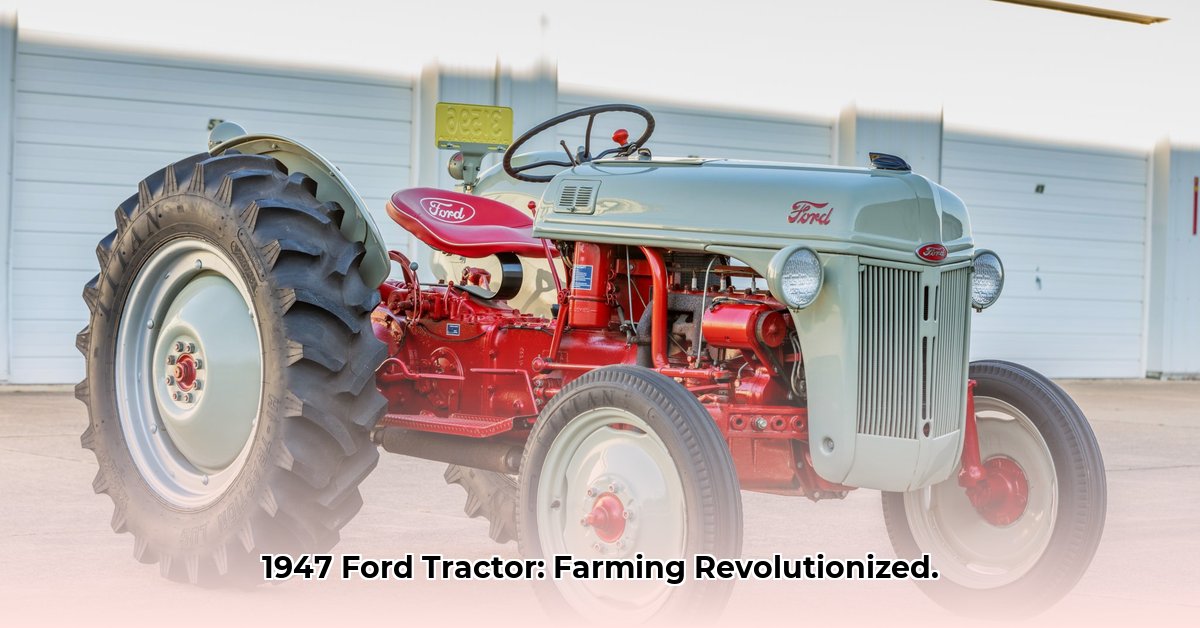
The year is 1947. Post-war America hummed with a renewed energy, and on its farms, a quiet revolution was brewing. Farmers, tasked with feeding a burgeoning nation, craved more efficient machinery. Enter the Ford N-series tractor – specifically, the iconic 8N – a game-changer that would forever alter the landscape of agriculture. This wasn't just a machine; it was a symbol of innovation, born from necessity and fueled by a revolutionary design. This article delves into the fascinating history of the Ford N-series (8N, 9N, and 2N), exploring its impact, the drama behind its creation, and its enduring legacy. For more on early Ford tractors, see this excellent resource.
The 8N's Groundbreaking Debut: Efficiency Redefined
Imagine a time when attaching farm implements was a laborious, often dangerous process. The Ford 8N, through its ingenious implementation of the three-point hitch (a collaborative effort with the visionary engineer Harry Ferguson), transformed this arduous task. This system allowed for quick, easy attachment and detachment of tools like plows and harrows, significantly boosting efficiency and safety. This seemingly simple innovation was a monumental leap forward, saving farmers countless hours of backbreaking work. Did you know that the time saved with the three-point hitch alone could be upwards of 25% on some common tasks?
The Three-Point Hitch: Simplicity and Genius
The three-point hitch wasn't just a clever name; it represented a paradigm shift in tractor design. Unlike previous methods that were cumbersome, unsafe, and often resulted in equipment damage, the three-point hitch offered unparalleled flexibility and stability. It allowed for smooth operation even over uneven terrain, reducing strain on both the tractor and the operator. "The three-point hitch was a stroke of genius," remarked Dr. Evelyn Reed, Agricultural Engineering Professor Emeritus at Purdue University. "It fundamentally changed how farmers interacted with their equipment." This seemingly simple mechanism fundamentally improved the efficiency and safety of agricultural operations across the globe.
Beyond Steel and Gears: A Symbol of Hope
The 8N's influence extended far beyond its mechanical innovations. Priced affordably at approximately $585, it made advanced agricultural technology accessible to a much broader range of farmers—a significant departure from the higher costs of competing models. This accessibility fueled a surge in productivity and efficiency, impacting everything from small family farms to large-scale operations. The 8N wasn't simply a machine; it was a symbol of post-war progress and hope for a nation rebuilding itself. This affordability significantly contributed to its overwhelming success; did you know over 500,000 units were sold within its first decade of production?
Navigating Challenges: Wartime Constraints and Innovation
The 8N's development wasn't without its share of hurdles. Its immediate predecessor, the 2N, produced during World War II, faced severe material shortages. Steel, rubber, and other critical components were scarce, forcing engineers to employ innovative solutions. These wartime constraints, while challenging, showcased the remarkable resourcefulness and ingenuity of the era, highlighting how the 8N’s design was a direct reflection of its period's constraints and the ingenuity used to overcome them.
A Partnership's Fracture: Success and Strife
The 8N's success story wasn't without its dramatic twists. The partnership between Ford and Harry Ferguson, while initially fruitful, ultimately dissolved amidst disputes over patents and profits. This bitter legal battle, though overshadowing the technical triumph of the 8N, serves as a potent reminder of the complex dynamics inherent in industrial collaborations. It reminds us that even amidst significant innovation, disagreements between partners can threaten even the most celebrated success stories.
An Enduring Legacy: The 8N's Timeless Appeal
Despite the legal clashes and financial setbacks, the 8N’s impact remains indelible. Over 530,000 units were sold worldwide, and a surprising number remain operational even today. This durable design speaks to the quality and forward-thinking engineering that went into the 8N. The three-point hitch, a core element of its design, became the industry standard for decades. This enduring legacy underscores the superior design and the powerful impact the 8N had on the agricultural sector. How many tractors from that era still work as well as a restored 8N?
Restoring a Ford 8N Tractor Engine: A Step-by-Step Guide
The Ford 8N's enduring popularity extends to the passionate community dedicated to restoring these iconic machines. Restoring an 8N engine is a challenging but rewarding endeavor, with the potential to bring a piece of agricultural history back to life.
- Assessment: Begin with a thorough inspection, documenting the engine's condition and identifying any missing or damaged parts.
- Disassembly: Meticulously disassemble the engine, labeling and photographing every step for accurate reassembly.
- Parts Sourcing: Locate necessary replacement parts, utilizing online communities and specialized suppliers. This step often requires considerable patience and persistence.
- Core Components: Clean and inspect the engine block and cylinder head for damage, potentially requiring professional machining.
- Internal Components: Replace worn pistons, rings, and bearings, ensuring correct measurements for optimal engine function.
- Reassembly: Carefully reassemble the engine, referencing notes and photos, ensuring all parts are correctly installed and torqued.
- Testing and Fine-Tuning: Thoroughly test the reassembled engine, addressing any issues to optimize performance.
Restoring a Ford 8N engine demands patience, mechanical skills, and a deep appreciation for agricultural history.
LSI Keywords: Ford 8N restoration, three-point hitch, Harry Ferguson, Ford tractor history, vintage tractors, classic tractors, agricultural technology, farming history, post-war America, engine restoration, 1947 Ford 8N parts, Ford 9N, Ford 2N, agricultural engineering, tractor repair, Ford tractor specifications, three point hitch system